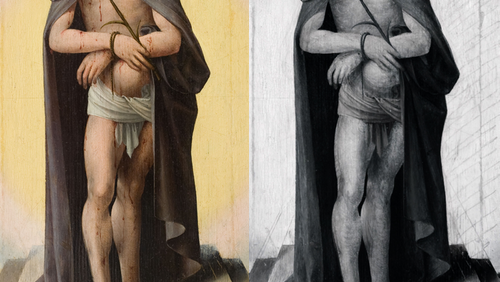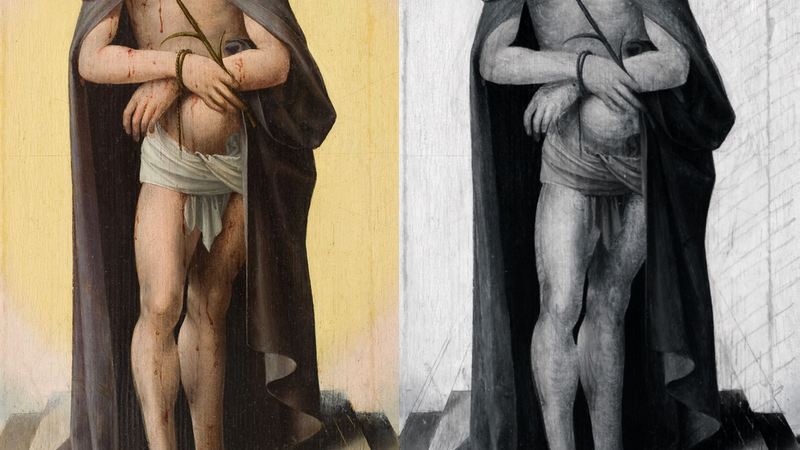Arts & Culture: Beneath a Painting’s Surface
A portrait of a bearded man in a jacket and bow tie hides beneath Picasso’s The Blue Room. A peasant woman stares out from under Patch of Grass by Van Gogh. These images, invisible to our eyes, have been uncovered by scientists studying paintings using infrared light and x rays, which both can penetrate paint layers. But paintings examined in this way are typically removed from gallery walls and taken to a university or facility that has the necessary tools—the Van Gogh painting was transported from a museum in Amsterdam to an x-ray synchrotron in Hamburg. The process is time-consuming, costly, and irritating to museumgoers, who are unable to gaze on the artwork for a few months. As a result, very few paintings end up being investigated by scientists. Physicist Charles Falco hopes to change this with portable scientific instrumentation.
For the last decade, Falco, a professor of optics at the University of Arizona and a collaborator of English artist David Hockney, has been traveling the world snapping paintings and art objects on display with a homebuilt infrared camera. In just a few hours of his time, Falco can capture a room full of artwork—something that might otherwise take scientists years. Recently he added to his tools a portable Raman spectrometer, an instrument that can determine the chemical composition of paint pigments. His ultimate goal is to develop a suite of compact instruments that can be carried anywhere to uncover the secret lives of artworks in a flash.
Portable instruments provide a quick-and-dirty way to study paintings. “Either the data alone tell us what we need to know, or [they prompt] more detailed studies,” said Falco. “I can make a quick measurement and say, look, this is interesting for the following reasons.”
One of the first paintings Falco examined with his infrared camera was a 16th-century painting by an unknown French artist of a Christ figure standing on a box. The painting hangs in the University of Arizona Museum of Art, just a few hundred meters from Falco’s office. In the infrared image of the painting, lines mapping out the box become visible, showing the sketch that the artist drew before he picked up the paintbrushes (see Fig. 1).
“You can actually see the lines … drawn to a vanishing point. The artist laid out that feature of the painting using the laws of geometrical perspective, ” said Falco. The finding was by chance—Falco was snapping away just to see if the camera worked. “Even if the university art museum had a laboratory in the basement filled with instruments, I can’t imagine anyone ever taking that particular scene off the wall to study,” he said.
Falco has also tried out his Raman spectrometer on a painting that was possibly made by Picasso. “I was able to determine with Raman spectroscopy that the pigments were of the same type Picasso was known to have used,” he said. Falco wouldn’t give me the full details of the painting because it currently lies in a private collection.
The first real test for the Raman spectrometer had been planned for mid-June 2017, when Falco visited The State Hermitage Museum in Saint Petersburg, Russia, to give a talk in its Art & Science seminar series. But at the last minute he decided against taking the instrument with him, because the device doesn’t yet have a case that would survive being tossed around on planes and conveyor belts. Studying paintings at the Hermitage “will have to wait until my next trip,” he said. On his agenda, however, was a discussion of an educational collaboration between the University of Arizona, ITMO University in Saint Petersburg, and the Hermitage. The collaboration aims to start a master’s program in which students develop new portable optical instrumentation at both universities and then test the devices on artworks at the museum.
“I am absolutely excited about the whole idea,” said Daria Kozlova, Vice Rector for International Relations at ITMO. According to Kozlova, their degree syllabus in art and photonics will be a new multidisciplinary endeavor. The course is still in the planning stages, but Kozlova expects to start accepting masters’ students a year from now.
The instruments that Falco, and possibly future students of the program, develop could be applied to all kinds of cultural artifacts, not just paintings in museums. He said, “if someone had been able to go to Aleppo five years ago [before it was destroyed by war] and document some artwork with infrared, ultraviolet, and Raman spectroscopy, it would have been a good thing. All that artwork doesn’t exist anymore.”
–Katherine Wright
Katherine Wright is a Contributing Editor for Physics.





